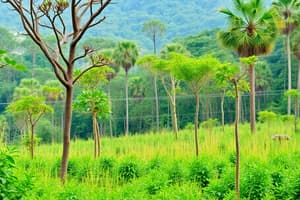Podcast
Questions and Answers
What is agroforestry?
What is agroforestry?
- A system that involves only agriculture
- A land management system that combines agriculture and forestry for multiple benefits (correct)
- A system that involves only forestry
- A system that involves only gardening
What is the scientific basis for agroforestry?
What is the scientific basis for agroforestry?
- Horticulture
- Agronomy
- Agroecology (correct)
- Botany
What are some advantages of agroforestry over conventional agricultural and forest production methods?
What are some advantages of agroforestry over conventional agricultural and forest production methods?
- Lower productivity, social, economic, and environmental benefits, as well as lower diversity in the ecological goods and services provided
- Only environmental benefits
- No benefits at all
- Increased productivity, social, economic, and environmental benefits, as well as greater diversity in the ecological goods and services provided (correct)
How does agroforestry contribute to sustainable agriculture?
How does agroforestry contribute to sustainable agriculture?
What are some types of agroforestry practiced worldwide?
What are some types of agroforestry practiced worldwide?
What are some obstacles to agroforestry adoption in the United States?
What are some obstacles to agroforestry adoption in the United States?
What could help overcome the obstacles to agroforestry adoption in the United States?
What could help overcome the obstacles to agroforestry adoption in the United States?
What is the USDA's role in promoting agroforestry?
What is the USDA's role in promoting agroforestry?
What is the Savanna Institute?
What is the Savanna Institute?
Flashcards
What is agroforestry?
What is agroforestry?
A land management system combining agriculture and forestry to create multiple benefits, such as increased yields, biodiversity, soil health, and carbon sequestration.
How does agroforestry differ from intercropping?
How does agroforestry differ from intercropping?
Intercropping involves growing multiple crops together, while agroforestry incorporates trees into the system, leading to more complex and diverse multi-strata forests.
What is agroecology?
What is agroecology?
A field of study that explores how to design and manage agricultural systems that mimic natural ecosystems, focusing on ecological principles like nutrient cycling and biodiversity.
What are some advantages of agroforestry over traditional agriculture?
What are some advantages of agroforestry over traditional agriculture?
Signup and view all the flashcards
How does agroforestry impact biodiversity?
How does agroforestry impact biodiversity?
Signup and view all the flashcards
What are the ecosystem services provided by agroforestry?
What are the ecosystem services provided by agroforestry?
Signup and view all the flashcards
How does agroforestry impact biodiversity conservation?
How does agroforestry impact biodiversity conservation?
Signup and view all the flashcards
How does agroforestry contribute to climate change mitigation and adaptation?
How does agroforestry contribute to climate change mitigation and adaptation?
Signup and view all the flashcards
What are the main obstacles to agroforestry adoption in the US, and how can they be overcome?
What are the main obstacles to agroforestry adoption in the US, and how can they be overcome?
Signup and view all the flashcards
Study Notes
Agroforestry is a land management system that combines agriculture and forestry for multiple benefits, such as enhanced yields, increased biodiversity, improved soil health, reduced erosion, and carbon sequestration. Agroforestry shares principles with intercropping but can also involve complex multi-strata agroforests containing hundreds of species. The scientific basis for agroforestry lies in agroecology, which encompasses diverse applications such as improved nutrient and carbon cycling, water retention of soils, biodiverse habitats, protection from pests, diseases, and weed outbreaks, and protection of soils from water and wind erosion. Agroforestry systems can be advantageous over conventional agricultural and forest production methods, offering increased productivity, social, economic, and environmental benefits, as well as greater diversity in the ecological goods and services provided. Biodiversity in agroforestry systems is typically higher than in conventional agricultural systems. Agroforestry systems can provide a number of ecosystem services that contribute to sustainable agriculture, such as carbon sequestration, cleaner water, and nutrient uptake. Agroforestry can help to conserve biodiversity, having a positive influence on other ecosystem services. Agroforestry can significantly contribute to climate change mitigation along with adaptation benefits. Agroforestry practices may realize a number of environmental goals, such as soil and plant growth, weed control, and adaptation to climate change. Agroforestry has been adopted in various regions worldwide, such as tropical agroforestry, hillside systems, shade crops, crop-over-tree systems, intercropping, alley cropping, Taungya, and Itteri agroforestry. The USDA distinguishes five applications of agroforestry for temperate climates, such as alley cropping and strip cropping, fauna-based systems, boundary systems, and silvopasture.Agroforestry in the United States: Obstacles and Solutions
- Agroforestry systems are not widely adopted in the US.
- The lack of awareness and knowledge about agroforestry is a major obstacle.
- The absence of financial incentives and technical assistance is also a major obstacle.
- The current agricultural policies and regulations discourage agroforestry adoption.
- The development of educational programs and demonstration projects could help overcome these obstacles.
- The integration of agroforestry into existing conservation programs could also help.
- The promotion of agroforestry through marketing and labeling could create demand for agroforestry products.
- The development of agroforestry cooperatives could help small farmers access markets.
- The creation of a national agroforestry policy could facilitate the adoption of agroforestry.
- The US Forest Service has a program to promote agroforestry.
- The USDA has a program to provide technical assistance and financial incentives for agroforestry.
- The Savanna Institute is a non-profit organization that promotes agroforestry in the Midwest.
Studying That Suits You
Use AI to generate personalized quizzes and flashcards to suit your learning preferences.




